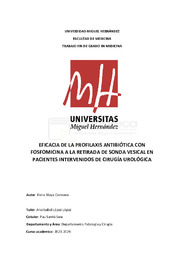Please use this identifier to cite or link to this item:
https://hdl.handle.net/11000/33712Eficacia de la profilaxis antibiótica con fosfomicina a la retirada de sonda vesical en pacientes intervenidos de cirugía urológica
| Title: Eficacia de la profilaxis antibiótica con fosfomicina a la retirada de sonda vesical en pacientes intervenidos de cirugía urológica |
| Authors: Blaya Carmona, Elena |
| Tutor: López López, Ana Isabel Sarrio Sanz, Pau |
| Editor: Universidad Miguel Hernández |
| Department: Departamentos de la UMH::Patología y Cirugía |
| Issue Date: 2024-05-03 |
| URI: https://hdl.handle.net/11000/33712 |
| Abstract: INTRODUCCIÓN: las infecciones del tracto urinario (ITU) asociadas al uso de sonda vesical son la causa de infecciones nosocomiales más frecuente en todo el mundo. Aunque tradicionalmente se ha administrado profilaxis antibiótica para prevenir infecciones al retirar la sonda, las directrices actuales cuestionan esta práctica. OBJETIVOS: conocer si hay diferencia estadísticamente significativa en la incidencia de ITU y/o de ingreso hospitalario tras la retirada de sonda vesical entre los pacientes con y sin profilaxis antibiótica a la retirada de sonda tras cirugía urológica. MATERIAL Y MÉTODOS: presentamos un estudio observacional de cohortes prospectivo. Se revisaron los pacientes intervenidos de cirugía urológica en el servicio de urología del Hospital de San Juan que precisaron alta con sonda vesical entre diciembre de 2022 y noviembre de 2023. En junio de 2023 se retiró la profilaxis antibiótica con fosfomicina 3g monodosis que tradicionalmente se realizaba. La ITU se definió como la necesidad de consulta del paciente por clínica miccional sugestiva de ITU en su centro de salud, consulta de urología u hospital en el mes siguiente a la retirada de la sonda. RESULTADOS: se revisaron un total de 333 pacientes de los que fueron incluidos 292. Presentaron clínica urinaria durante el mes posterior a la retirada de sonda vesical 18,4% del grupo de pacientes que recibió profilaxis antibiótica y 27,9% del grupo de pacientes que no la recibió, siendo esta una diferencia estadísticamente no significativa (p=0,054). Precisaron ingreso durante el mes posterior a la retirada de sonda vesical 2,45% del grupo de pacientes que recibió profilaxis antibiótica y 8,53% del grupo de pacientes que no la recibió, siendo esta una diferencia estadísticamente significativa (p=0,020). DISCUSIÓN: la administración de profilaxis antibiótica en el momento de la retirada de sonda vesical se ha realizado tradicionalmente en muchos servicios de urología. Sin embargo, el creciente problema de resistencia antibiótica nos obliga a replantearnos estas actitudes no respaldadas por la evidencia científica. Si bien el presente estudio no ha logrado evidenciar una diferencia estadísticamente significativa en la incidencia de ITU en pacientes en los que no se ha administrado profilaxis (p=0,054), se ha demostrado una mayor incidencia de ingresos en estos pacientes. CONCLUSIONES: la profilaxis con fosfomicina a la retirada de la sonda no ha demostrado reducir la incidencia de ITU en los pacientes intervenidos de cirugía urológica (aunque el resultado de p-valor tan cercano al valor significativo debe hacernos sospechar una relación y guiar nuevas investigaciones). Sí se ha ha evidenciado una disminución en el número de ingresos por ITU. INTRODUCTION: urinary tract infections (UTIs) associated with indwelling urinary catheters are the most common nosocomial infections worldwide. Although antibiotic prophylaxis has traditionally been administered to prevent infections upon catheter removal, current guidelines question this practice. OBJECTIVES: to determine if there is a statistically significant difference in the incidence of UTIs and/or hospital admission following urinary catheter removal among patients undergoing urological surgery who required a urinary catheter upon discharge, with and without antibiotic prophylaxis at catheter removal. MATERIALS AND METHODS: we present a prospective observational cohort study. Patients undergoing urological surgery at the Urology Department of San Juan Hospital who required discharge with a urinary catheter between December 2022 and November 2023 were reviewed. In June 2023, prophylactic antibiotic administration with single-dose fosfomycin 3g, traditionally performed, was discontinued. UTI was defined as the need for patient consultation due to suggestive urinary symptoms in their primary care center, urology clinic, or hospital within the month following catheter removal. RESULTS: a total of 333 patients were reviewed, of whom 292 were included. Urinary symptoms were reported during the month following urinary catheter removal in 18.4% of patients who received antibiotic prophylaxis and 27.9% of patients who did not, with this difference not statistically significant (p=0.054). Hospital admission within the month following catheter removal occurred in 2.45% of patients who received antibiotic prophylaxis and 8.53% of patients who did not, with this difference statistically significant (p=0.020). DISCUSSION: the administration of antibiotic prophylaxis at the time of urinary catheter removal has traditionally been performed in many urology services. However, the growing problem of antibiotic resistance requires us to reconsider these practices unsupported by scientific evidence. While the present study did not demonstrate a statistically significant difference in the incidence of UTIs in patients who did not receive prophylaxis (p=0.054), a higher incidence of hospital admissions in these patients was demonstrated. CONCLUSIONS: prophylaxis with fosfomycin upon catheter removal has not been shown to reduce the incidence of UTIs in patients undergoing urological surgery (although the result of a p-value so close to the significant value should raise suspicion and guide further research). However, a decrease in the number of admissions due to UTIs was evidenced. |
| Keywords/Subjects: infecciones del tracto urinario (ITU) sonda vesical infecciones nosocomiales profilaxis antibiótica |
| Knowledge area: CDU: Ciencias aplicadas: Medicina |
| Type of document: info:eu-repo/semantics/bachelorThesis |
| Access rights: info:eu-repo/semantics/openAccess |
| Appears in Collections: TFG- Medicina |
.png)

